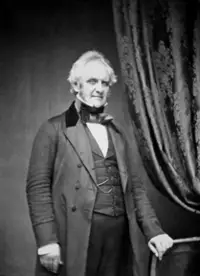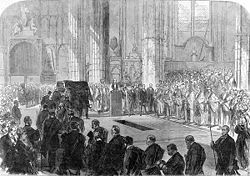Encyclopedia, Difference between revisions of "George Peabody" - New World
(Started) |
m (Robot: Recategorize as Economists) |
||
| Line 2: | Line 2: | ||
[[Category:Sociology]] | [[Category:Sociology]] | ||
[[Category:Politics and social sciences]] | [[Category:Politics and social sciences]] | ||
| − | [[Category: | + | [[Category:Economists]] |
[[Category:Biography]] | [[Category:Biography]] | ||
Revision as of 00:45, 13 September 2007
- This article is about George Peabody, a dry goods merchant and philanthropist in the northern United States, founder of the Peabody Institute. For information about George Peabody, the capitalist and promoter of education in the southern United States, see George Foster Peabody.
George Peabody (February 18 1795 – November 4 1869) was an entrepreneur and philanthropist who founded the Peabody Institute. He was born in what was then Danvers, Massachusetts (now Peabody, Massachusetts), to a middle class family. His birthplace at 205 Washington Street in Peabody is now the George Peabody House Museum ([1]), a museum dedicated to preserving his life and legacy.
While serving as a volunteer in the War of 1812, Peabody met Elisha Riggs, who, in 1814, provided financial backing for the wholesale dry goods firm of Peabody, Riggs, and Company.
In 1816, Peabody moved to Baltimore, where he would live for the next 20 years.
The town of South Danvers, Massachusetts changed its name to The City of Peabody, Massachusetts in honor of its favorite son. Peabody is a member of the Hall of Fame for Great Americans located at the Bronx Community College, at the former site of New York University (NYU).
In the 1830s, Peabody moved to London, where he would spend the rest of his life.
There he started a bank with financing from the Rothschilds and entered into a partnership with Junius Morgan, father of J. P. Morgan; today's assorted financial businesses with the name Morgan trace their roots to Peabody's bank. (Chernow: The House of Morgan)
In London, Peabody established the Peabody Donation Fund, which continues to this day, as the Peabody Trust, to provide subsidized housing in London. The first dwellings opened by the Peabody Trust for the "artisans and labouring poor of London" were opened in Commercial Street, Whitechapel in February 1864. They were designed by the architect H.A. Darbyshire in an attractively ornate style, a break from the convention of Gothic that private clients came to require of him.
Peabody was made a Freeman of the City of London, the motion being proposed by Charles Reed in recognition of his financial contribution to London's poor.
In America, Peabody founded and supported numerous institutions in New England and elsewhere. At the close of the American Civil War, he established the Peabody Education Fund to "encourage the intellectual, moral, and industrial education of the destitute children of the Southern States." His grandest beneficence, however, was to Baltimore; the city in which he achieved his earliest success.
George Peabody is known to have provided benefactions of more than $8 million, most of them in his own lifetime. Among the list are included:
- 1852 The Peabody Institute (now the Peabody Institute Library), Peabody, Mass: $217,000
- 1856 The Peabody Institute, Danvers, Mass: $100,000
- 1857 The Peabody Institute, Baltimore: $1,400,000
- 1862 The Peabody Donation Fund, London: $2,500,000
- 1866 The Peabody Museum of Archaeology and Ethnology, Harvard University
- 1866 The Peabody Museum of Natural History, Yale University: $150,000
- 1867 The Peabody Essex Museum, Salem, Mass: $140,000
- 1867 The Peabody Institute, Georgetown, District of Columbia: $15,000 (today the Peabody Room, Georgetown Branch, DC Public Library).
- 1867 Peabody Education Fund: $2,000,000
Peabody is the acknowledged father of modern philanthropy, having established the practice later followed by Andrew Carnegie, John D. Rockefeller, and Bill Gates.
George Peabody never married. He died in London on November 4 1869, aged 74. At the request of the Dean of Westminster and with the approval of the Queen, Peabody was given a temporary burial in Westminster Abbey.
His will provided that he be buried in the town of his birth, Danvers, Massachusetts, and Prime Minister Gladstone arranged for Peabody's remains to be returned to America on HMS Monarch, the newest and largest ship in Her Majesty's Navy. He is buried in Peabody, Massachusetts, at Harmony Grove Cemetery.
A statue of him stands next to the Royal Exchange in the City of London, unveiled in 1869 shortly before his death. There is a similar statue of him next to the Peabody Institute, in Mount Vernon Park, part of the Mount Vernon neighborhood of Baltimore, Maryland.
Publications
- Severn Teackle Wallis, Discourse on the Life and Character of George Peabody, (1870)
- J. L. M. Curry, A Brief Sketch of George Peabody and a History of the Peabody Education Fund through Thirty Years. (Cambridge, 1898)
- Franklin Parker, "George Peabody: A Biography." (Vanderbilt University, 1995)
Credits
New World Encyclopedia writers and editors rewrote and completed the Wikipedia article in accordance with New World Encyclopedia standards. This article abides by terms of the Creative Commons CC-by-sa 3.0 License (CC-by-sa), which may be used and disseminated with proper attribution. Credit is due under the terms of this license that can reference both the New World Encyclopedia contributors and the selfless volunteer contributors of the Wikimedia Foundation. To cite this article click here for a list of acceptable citing formats.The history of earlier contributions by wikipedians is accessible to researchers here:
The history of this article since it was imported to New World Encyclopedia:
Note: Some restrictions may apply to use of individual images which are separately licensed.


